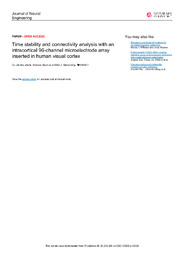Please use this identifier to cite or link to this item:
https://hdl.handle.net/11000/35182Full metadata record
| DC Field | Value | Language |
|---|---|---|
| dc.contributor.author | Grani, Paolo | - |
| dc.contributor.author | Soto-Sánchez, Cristina | - |
| dc.contributor.author | Farfan, Fernando Daniel | - |
| dc.contributor.author | Alfaro Sáez, Arantxa | - |
| dc.contributor.author | Grima, María Dolores | - |
| dc.contributor.author | Rodil, Alfonso | - |
| dc.contributor.author | Fernández, Eduardo | - |
| dc.contributor.other | Departamentos de la UMH::Histología y Anatomía | es_ES |
| dc.date.accessioned | 2025-01-23T20:03:00Z | - |
| dc.date.available | 2025-01-23T20:03:00Z | - |
| dc.date.created | 2022-07-22 | - |
| dc.identifier.citation | J Neural Eng . 2022 Jul 22;19(4) | es_ES |
| dc.identifier.issn | J Neural Eng . | - |
| dc.identifier.uri | https://hdl.handle.net/11000/35182 | - |
| dc.description.abstract | Objective. Microstimulation via electrodes that penetrate the visual cortex creates visual perceptions called phosphenes. Besides providing electrical stimulation to induce perceptions, each electrode can be used to record the brain signals from the cortex region under the electrode which contains brain state information. Since the future visual prosthesis interfaces will be implanted chronically in the visual cortex of blind people, it is important to study the long-term stability of the signals acquired from the electrodes. Here, we studied the changes over time and the repercussions of electrical stimulation on the brain signals acquired with an intracortical 96-channel microelectrode array implanted in the visual cortex of a blind volunteer for 6 months. Approach. We used variance, power spectral density, correlation, coherence, and phase coherence to study the brain signals acquired in resting condition before and after the administration of electrical stimulation during a period of 6 months. Main results. Variance and power spectral density up to 750 Hz do not show any significant trend in the 6 months, but correlation coherence and phase coherence significantly decrease over the implantation time and increase after electrical stimulation. Significance. The stability of variance and power spectral density in time is important for long-term clinical applications based on the intracortical signals collected by the electrodes. The decreasing trends of correlation, coherence, and phase coherence might be related to plasticity changes in the visual cortex due to electrical microstimulation. | es_ES |
| dc.format | application/pdf | es_ES |
| dc.format.extent | 16 | es_ES |
| dc.language.iso | eng | es_ES |
| dc.publisher | IOP Publising | es_ES |
| dc.rights | info:eu-repo/semantics/openAccess | es_ES |
| dc.rights | Attribution-NonCommercial-NoDerivatives 4.0 Internacional | * |
| dc.rights.uri | http://creativecommons.org/licenses/by-nc-nd/4.0/ | * |
| dc.subject | neuroprosthesis | es_ES |
| dc.subject | brain plasticity | es_ES |
| dc.subject | long-term measurements | es_ES |
| dc.title | Time stability and connectivity analysis with an intracortical 96-channel microelectrode array inserted in human visual cortex | es_ES |
| dc.type | info:eu-repo/semantics/article | es_ES |
| dc.contributor.institute | Institutos de la UMH::Instituto de Bioingeniería | es_ES |
| dc.relation.publisherversion | 10.1088/1741-2552/ac801d. | es_ES |

View/Open:
Time stability and connectivity analysis with an intracortical 96-channel microelectrode array inserted in human.pdf
12,66 MB
Adobe PDF
Share:
.png)
